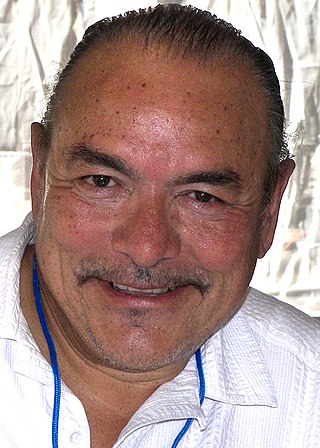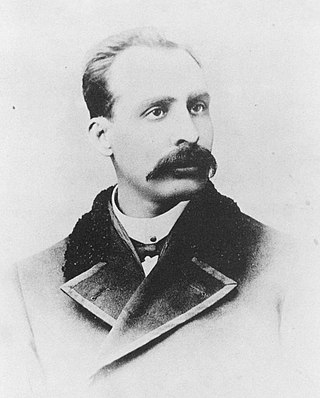Related Research Articles

Bee County is a county located in the U.S. state of Texas. It is in South Texas and its county seat is Beeville. As of the 2020 census, its population was 31,047. The Beeville, TX micropolitan statistical area includes all of Bee County. The county was founded December 8, 1857, and organized the next year. It is named for Barnard E. Bee, Sr., a secretary of state of the Republic of Texas.

Tejano music, also known as Tex-Mex music, is a popular music style fusing Mexican and US influences. Typically, Tejano combines Mexican Spanish vocal styles with dance rhythms from Czech and German genres – particularly polka or waltz. Tejano music is traditionally played by small groups featuring accordion and guitar or bajo sexto. Its evolution began in northern Mexico.

In Aztec religion, Ītzpāpālōtl[iːt͡spaːˈpaːlot͡ɬ] was a striking skeletal warrior and death goddess and queen of the Tzitzimimeh "star demons", who ruled over the paradise world of Tamoanchan, the paradise of victims of infant mortality and the place identified as where humans were created. She is the mother of Mixcoatl and is particularly associated with the moth Rothschildia orizaba from the family Saturniidae. Some of her associations are birds and fire. However, she primarily appears in the form of the Obsidian Butterfly.

Tejanos are the residents of the state of Texas who are culturally descended from the Mexican population of Tejas and Coahuila that lived in the region prior to it becoming what is now known as the state of Texas before it became a U.S. state in 1845. The term is also sometimes applied to all Texans of Mexican descent.
Latino Americans have received a growing share of the national vote in the United States due to their increasing population. As of the 2020 U.S. Census, 62.1 million Latinos live in the United States, representing 18.9% of the total U.S. population. This is a 23% increase since 2010. This racial/ethnic group is the second largest after non-Hispanic whites in the U.S. In 2020, the states with the highest Hispanic or Latino populations were; Arizona, California, Florida, Illinois, Nevada, New Jersey, New Mexico, New York, and Texas. According to the Brookings Institute, Latinos will become the nations largest minority by 2045 and the deciding population in future elections. With the help of laws and court case wins, Latinos have been able to receive the help needed to participate in American Politics. According to data provided by The Collaborative Multiracial Post-Election Survey (CMPS), 72% of Latinos believe that it is very/somewhat important to get their voice heard by voting. They have traditionally been a key Democratic Party constituency, but more recently have begun to split between the Democratic and Republican Party. Since the Latino population is large and diverse, a lot of political differences exist between gender, national origin, and generational groups.
Hispanophobia or anti-Spanish sentiment is a fear, distrust, hatred of; aversion to, or discrimination against the Spanish language, Hispanic, Latino and/or Spanish people, and/or Hispanic culture. The historical phenomenon has gone through three main stages by originating in 16th-century Europe, reawakening during 19th-century disputes over Spanish and Mexican territory such as the Spanish–American War and the Mexican–American War, and continuing to exist to the present day in tandem with politically-charged controversies such as bilingual education and illegal immigration to the United States.

David Montejano is an American sociologist and historian.

The city of Houston has significant populations of Mexican Americans, Mexican immigrants, and Mexican citizen expatriates. Houston residents of Mexican origin make up the oldest Hispanic ethnic group in Houston, and Jessi Elana Aaron and José Esteban Hernández, authors of "Quantitative evidence for contact-induced accommodation: Shifts in /s/ reduction patterns in Salvadoran Spanish in Houston," referring to another large Latino group in Houston, stated that as of 2007 it was the most "well-established" Hispanophone ethnic group there. Houston is the third city for Mexican immigrants after Chicago and Los Angeles.

Indigenous peoples lived in the area now known as Texas long before Spanish explorers arrived in the area. However, once Spaniards arrived and claimed the area for Spain, a process known as mestizaje occurred, in which Spaniards and Native Americans had mestizo children who had both Spanish and indigenous blood. Texas was ruled by Spain as part of its New Spain territory from 1520, when Spaniards first arrived in Mexico in 1520, until Texas won independence from Mexico in 1836, which led to the Treaty of Guadalupe-Hidalgo (1848). In 1830, the Mexican population fell to 20 percent and in 1840 down to 10 percent. When Spanish rule in Texas ended, Mexicans in Texas numbered 5,000. In 1850 over 14,000 Texas residents had Mexican origin. During the Mexican Revolution (1910-1920) had brought in a lot of movement of Mexicans into Texas, passing through the Rio Grande. Most working opportunities for the Mexicans was working on a ranch or a farm starting from South Texas and ending up in the Panhandle in Northwest Texas to cotton lands. By (1930) the Mexican population grew to approximately 700,000.
Leonel Maciel is a Mexican artist, member of the Salón de la Plástica Mexicana, from the coast of the state of Guerrero. Although from a rural area and farming family, he studied art at the Escuela Nacional de Pintura, Escultura y Grabado "La Esmeralda" and has traveled extensively in Europe and Asia, which has influenced his work. His art has changed styles from generally contains multiple elements and saturated colors.
Hispanic and Latino Texans are residents of the state of Texas who are of Hispanic or Latino ancestry. As of the 2020 U.S. Census, Hispanics and Latinos of any race were 39.3% of the state's population. Moreover, the U.S Census shows that the 2010 estimated Hispanic population in Texas was 9.7 million and increased to 11.4 million in 2020 with a 2,064,657 population jump from the 2010 Latino population estimate.
This is a Mexican American bibliography. This list consists of books, and journal articles, about Mexican Americans, Chicanos, and their history and culture. The list includes works of literature whose subject matter is significantly about Mexican Americans and the Chicano/a experience. This list does not include works by Mexican American writers which do not address the topic, such as science texts by Mexican American writers.
Sara Estela Ramírez was a Mexican teacher, journalist, labor organizer, activist, feminist, essayist, and poet, who lived in the U.S. state of Texas. She founded two daily literary periodicals, La Corregidora and Aurora. She has been considered a key member in the support of the Partido Liberal Mexicano, and an early precursor to the modern Chicana feminist movement.

Pinto or Pinta is a member of a Chicano subculture of people who are or have been incarcerated. It is an in-group moniker used to distinguish oneself from the general prison population or from "model inmates." It is a term which embraces the oppositional elements of being a Convicto. The term came from a bilingual play on the Spanish word for penitencia (penitence), since pintos and pintas are people who have spent time in penitentiaries. The term has also been traced to the Spanish word Pintao.

Catarino Erasmo Garza (1859–1895) was a journalist, folk hero and revolutionary. He published Spanish language newspapers in the United States, founded mutual aid societies, and is perhaps best known for the unsuccessful Garza Revolution near the Texas Mexican border. Garza was born in Matamoros, Tamaulipas and moved to Brownsville in 1877. After his revolution's failure in Texas, Garza fled to Costa Rica, where he joined a group of revolutionaries. He was killed in Panama at the age of 35.
"Let All of Them Take Heed": Mexican Americans and the Campaign for Educational Equality in Texas, 1910-1981 is a non-fiction book by Guadalupe San Miguel, Jr., published by University of Texas Press in 1987. Let All of Them Take Heed argues that Mexican-Americans in the period saw education as central to success in the United States, with participation in League of United Latin American Citizens being key evidence. The book argues against the idea that the ethnic group did not place value in education. According to Richard A. Garcia of Santa Monica College, "Let All of Them Take Heed" "is the first major work to give credence to the reality of a strong Mexican American civil rights movement[...]"
The Texas-Mexican Conjunto: History of a Working-Class Music is a 1985 non-fiction book by Manuel H. Peña, published by University of Texas Press. It documents Tejano conjunto music established in the 20th century. The author states that the music reflects how communities on the Mexico-United States border evolved and how the communities opposed assimilating to the dominant American culture.
Rise of the Mexican American Middle Class: San Antonio, 1929-1941 is a non-fiction book by Richard A. Garcia, published in 1991 by the Texas A&M University Press.
References
- de la Garza, Rodolfo O (1989). "Anglos and Mexicans in the Making of Texas, 1836-1986". Southwestern Historical Quarterly . 93 (1): 115–117. JSTOR 30241270.
- Maciel, David R. (1989-02-01). "Anglos and Mexicans in the Making of Texas, 1836-1986". Hispanic American Historical Review . 69 (1): 176–177. doi: 10.1215/00182168-69.1.176 .
{{cite journal}}: CS1 maint: date and year (link) - Valdez, Avelardo (1989). "Anglos and Mexicans in the Making of Texas, 1836-1986". International Migration Review . 23 (1): 120–121. doi: 10.1177/019791838902300107 . S2CID 150113666.
Notes
- ↑ Anglos y mexicanos en la formación de Texas: 1836-1986. Vol. 84. Consejo Nacional para la Cultura y las Artes, 1991.
- 1 2 Maciel.
- ↑ Valdez, p. 120.
- ↑ "Frederick Jackson Turner Award Winners". Organization of American Historians . Retrieved 2022-09-04.
- ↑ de la Garza, p. 115.
- ↑ de la Garza, p. 116.
- ↑ Valdez, p. 121.